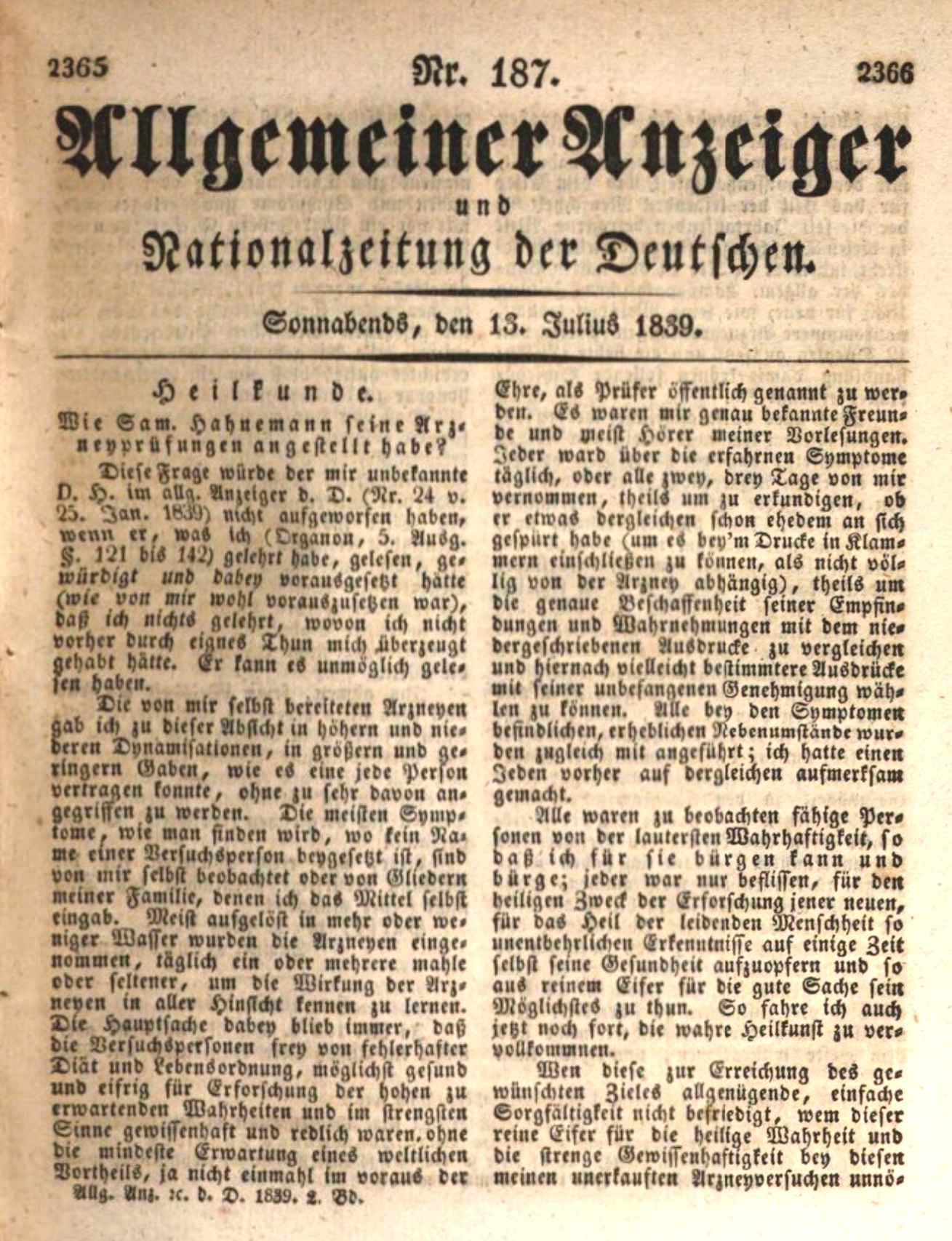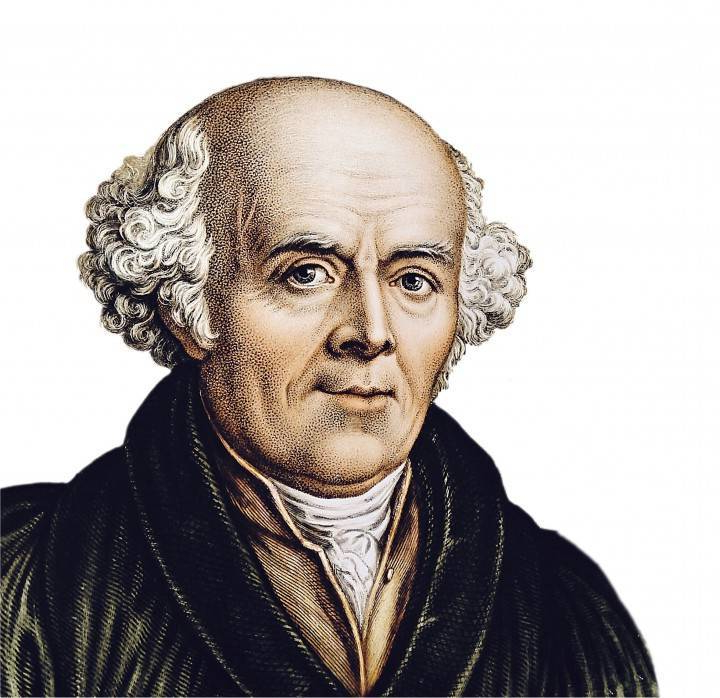Source 3: Observations from medical treatments
With increasing practical experience, Hahnemann used the realisation that not only healthy people but also chronically ill people could make valuable contributions to the Materia Medica - especially through unintentional drug reactions that occurred when prescribing drugs that were not optimally suited - and noted this in Organon § 142 (cf.: Hahnemann, 1996, p. 205; author’s transl.):
"But how to determine even in diseases, especially in the mostly constant chronic ones, in addition to the symptoms of the original disease, also some symptoms* of the simple remedy administered for treatment, is very demanding and can only be left to masters in observation.
*FN: i.e. symptoms that were either only noticed a long time ago or have never been noticed in the entire history of the disease and are therefore new to the remedy"
Chronically ill patients react more sensitively to medicines that are only partially suitable
As early as 1801, in his text Über die Kraft kleiner Gaben der Arzneien generell und der Belladonna insbesondre, he pointed out the special sensitivity of sick people to inaccurately chosen remedies. He also addressed doubts about the efficacy of high dilutions and argued that a small amount of belladonna usually had no effect on a "robust, completely healthy countryman".
"It by no means follows from this, however, that one gran of this thick juice would be an adequate or even too weak a dose for this or a similarly robust man, if he were ill and his illness were of a kind not suited to Belladonna." (cf: Über die Kraft kleiner Gaben der Arzneien überhaupt und der Belladonna insbesondre (Hahnemann, 1801 in: Hahnemann, 2001d, p. 349; author’s transl.)
Even stronger reactions are to be expected in patients if the medicine has been preserved, diluted and shaken with alcohol.
"Will we at last realise how small - indeed, how infinitely small - the doses of medicines may be in cases of disease, in order nevertheless to affect the body markedly?
Yes, they affect it strongly if the remedy is wrongly chosen: New, violent symptoms appear, and it is customary to say - whether rightly or wrongly, it remains to be seen - that the disease has worsened.
The remedy has an equally strong effect if it is chosen correctly: even the most serious illnesses often disappear within a few hours." (cf: Über die Kraft kleiner Gaben der Arzneien überhaupt und der Belladonna insbesondre (Hahnemann, 1801) in: Hahnemann, 2001d, p. 350; author’s transl.)
Partially suitable medicines provoke new reactions
In the Organon, Hahnemann explains this fact (Org. §175-182) to the effect that the "outlines of the form of the disease" (§175), i.e. the symptom pattern, are not clearly recognisable in every patient from the beginning .
In such cases, only the most suitable homeopathic remedy can initially be selected on the basis of the few symptoms identified.
"Now the remedy, chosen as well as possible, but [...] only imperfectly homœopathic, will, in its action against the disease only partially analogous to it, [...] excite secondary complaints, and interfere with the patient's condition by several accidents from its own series of symptoms [...]" (Hahnemann, 1996, § 180, p. 223 f. ; author’s transl.)
"[...] but they are always only such symptoms as this disease was already capable of manifesting in this body, and which were merely drawn out and induced to appear by the medicine used [...]." (Hahnemann, 1996, § 181, p. 224; author’s transl.)
While a healthy organism usually tolerates and compensates for homeopathic druc stimuli better, chronically ill patients often react more sensitively and subtly. This can provoke clear drug effects in individual cases, which, however, still need to be further tested for their evidence - a procedure that Hahnemann practised very specifically.
The "NB" labelling
From the D3 journal (1802) onwards, Hahnemann labelled newly appearing changes in a patient's condition that were previously unknown and only appeared after the administration of a remedy as drug symptoms with the abbreviation NB (Papsch, 1998). This abbreviation is interpreted both as nota bene ("well noted") and as a secondary complaint. Exactly which term Hahnemann meant by NB is of secondary importance - what is decisive is its meaning. Hahnemann used the abbreviation NB in his medical journals to indicate newly occurring symptoms that were assigned to the last remedy administered.
"Hahnemann crossed out the 'NB' signs in the journal text as soon as the symptoms labelled with them could be regarded as confirmed and adopted the statements marked in this way in the 'Fragmenta' and later in the Pure Pharmacopoeia. Journal N.5 contains 81 cancelled 'NB' symptoms." (Varady, 1987, p. 284; author’s transl.)
In the medical journal D16 (1817 - 1818), for example, 43 Thuja, 11 Cicuta and 10 Staphysagria signs were identified, which occurred as an effect during treatment with the remedy and were integrated into the pharmacopoeia (Schuricht, 2004, p. 147). The case history of Antonie Volkmann contributed 46 Sepia-, 17 Nit-ac-and 16 Phosphorus remedy effects. (Hahnemann, 2007, ed. Lucae & Wischner, p. 6f.)
How Hahnemann used this working abbreviation was investigated by the authors in the transcriptions and analyses of various medical journals. (Varady, 1987; Seiler, 1988; Schuricht, 2004; Fischbach-Sabel, 20). As they were able to prove, the abbreviation was primarily used to:
- Labelling of new symptoms in the medical journals:
- If a patient showed new symptoms after taking a homeopathic remedy, Hahnemann labelled them with the abbreviation NB
- He considered these newly occurring drug reactions to be potentially caused by the last administered and not optimally suitable drug. He therefore considered attributing this observation to this drug
- Cancellation of the NB abbreviation:
- As soon as Hahnemann regarded the new drug reactions as confirmed drug-specific effects or wanted to include them in his Materia Medica (pharmacopoeia), he crossed out the NB abbreviation.
- This meant that this drug reaction was now considered tested and documented.
- Not all observations labelled with NB can be found in later new editions of his pharmacopoeias. This indicates that Hahnemann linked their adoption to certain verification criteria - without, however, explicitly naming them.
- Significance for the drug trials:
- The NB abbreviation was part of his systematic approach to homeopathic drug proving (HDP). It helped him to analyse and document the effect of certain substances on the organism.
This practice shows how Hahnemann incorporated his observations into the development of homeopathy in a structured and systematic way.
After the transcriptions of some patients' journals, however, a debate arose as to whether these "NB symptoms" in the pharmacopoeia should be equated with the "genuine" drug reactions observed in trials on healthy people (Mortsch, 2005). Hahnemann apparently did so and also justified this in Org. § 156:
"It is not uncommon that even an apparently suitably chosen homeopathic remedy, especially when given in too small a dose in very irritable and sensitive patients, provokes at least a small, unusual complaint or a small, new symptom during its period of action. For it is almost impossible for a remedy and a disease to coincide in their symptoms as exactly as two congruent triangles. But this - in a favourable case - insignificant deviation is easily compensated for by the living organism's own self-regulation and is not even noticed by relatively insensitive patients; the regeneration nevertheless continues to progress towards the goal of recovery, if it is not disturbed by foreign medicinal influences on the patient, by errors in the order of life, or by mental and psychological obstacles to healing." (cf.: Organon § 156, Hahnemann, 1995; author’s transl.)


